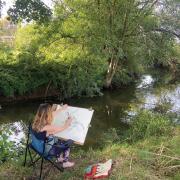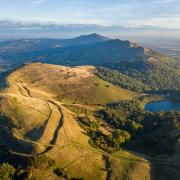On a ridge in the heart of the Cotswolds, with big views north into Warwickshire and south into Oxfordshire, stands one of England’s most important clusters of prehistoric megaliths. Thanks especially to a thorough gathering of folklore in 1895 by Arthur Evans – famed excavator of Knossos in Crete – the stones are also blessed with many strange tales. To make a visit, you can park in the layby beside the site or, if you fancy a proper walk, park in Chipping Norton and hike across the fields.
The megaliths comprise a large standing stone just north of the road (the King Stone), a stone circle south of the road (the King’s Men), and a dolmen – the remains of a chambered tomb – along a path to the east (the Whispering Knights). Immediately north of the King Stone rises a man-made earth bank from the top of which you can see the village of Long Compton.
The story goes that, long ago, a King was leading his army to do battle with a rival war-band. On the eve of the fight, his knights drew aside and plotted to betray him to the enemy. Suddenly a witch appeared to the King and said, ‘Seven long strides shalt thou take, and if Long Compton thou canst see, King of England thou shalt be.’

The King began to stride forwards, saying, ‘Stick, stock, stone! As King of England I shall be known!’
Just as he was about to take his seventh stride, the ground reared up before him, forming the earth bank and so obscuring his view. The witch chanted, ‘As Long Compton thou canst not see, King of England thou shalt not be. Rise up, stick, and stand still, stone, for King of England thou shalt be none. Thou and thy men hoar stones shall be, and I myself an eldern tree.’
At once the King was turned to stone, his war-band became the circle of stones, and his knights, huddling together to plan their treachery, became the stones of the dolmen. The elder tree into which the witch transformed was already gone in Evans’s day, but clumps of elder thicket still flourish on the site today.

The stone circle was once a continuous wall of closely set stones, except for the entrance to the south. It undoubtedly served a ritual purpose when it was first erected, some 5000 years ago, and its sacred ambience has endured ever since, suffusing the gatherings of naked witches alleged in the 16th century, the Midsummer Eve festivals of cake and ale in more recent times, and the celebration of the quarter festivals by Druids today.
Fairies have been reported dancing around the King Stone after emerging from a hole in the earth bank. The King’s Men are said to regain fleshly form at midnight, join hands, and dance in the air. At midnight too, the King and the Whispering Knights may head down to a nearby stream for a drink. The stones of the circle are said to be uncountable; a baker once tried to pin down the number by placing a loaf on each stone, but unfortunately he kept finding stones without a loaf because the fairies were stealing them.
To interpret some of this folklore, Evans drew upon contemporary beliefs in India that sacred standing stones carried the spirits of the dead. The story of the baker’s loaves could be a cultural memory of making offerings to the spirits. The stones’ midnight transformation and going for a drink bespeak the longing of the dead to regain living bodies and quench their thirst. Indeed, the Rollright story continues that some day the King and his men will become flesh and blood once more and the King will then defeat his enemies and become King of England.

Some of the stones have at times been taken away and at other times brought back. The capstone of the dolmen was one dragged with great difficulty, using 20 horses, down to the stream by Rollright Farm to make a bridge. Next morning the stone had flipped back on to the grass. After this had happened three nights running, they took it back where it had come from. A single horse easily did the job this time, though dragging the stone uphill.
The stones’ irregular shapes have developed not just from natural erosion over the centuries. People would chip off pieces from them to carry away as protective charms, especially soldiers going to war and drovers passing along the road, which is as ancient as the megaliths and, according to Evans, is lined with further stones, which if they’re still there must now be hidden in the hedgerows. In the 20th century, the King Stone and the Whispering Knights were encircled with steel fences to protect them from such depredations.
In times past, a man driving a cart along the road boasted to his mate, ‘I’ll take a chip from this King Stone even if my wheel shalt lock.’ He chipped off a piece of stone – and, lo and behold, one of his cart wheels locked so hard that nothing he could do would make it rotate. Another tale tells of another man driving a cart past the Rollright Stones who met a witch. At once one of his wheels fell off – but he was able to drive on because, by the witch’s power, his cart kept going with only one wheel.
Could this be the same witch who petrified the King? The kinship of witch with elder tree is supposedly explained by the notion that, like a witch – that is, a human being! – an elder will bleed when it’s cut. Evans met an old man who’d once, when the ancient elder was still standing, persuaded a boy to test this by pushing a knife into the tree. When the boy pulled out the knife he was too scared to look to see if the tree bled.

The previous time I visited the Rollright Stones, there was a wicker sculpture of the elder-witch. She, too, is gone now, lost to decay and vandalism. In the witch of Rollright, Evans perceived a memory of the tree goddesses of ancient times, such as the Greek dryads. Such feminine spirituality has perhaps fed into the traditions of infertile wives pressing their nipples upon the cold stone of the King’s Men, and of young women pressing their ears to the Whispering Knights to hear whispered prophecies of whom they’d marry.
The enduring sanctity of the place is evident in the offerings of coins in the crevices of the Whispering Knights and the many clooties tied on a tree beside the stone circle. That tree is an ash and will soon have to be felled, because of ash dieback, and the clooties transferred to another tree. Robin Smitten, the site manager, told me that several other ashes along the path to the dolmen are infected too.
The Rollright Trust, which owns the site, wishes to preserve the authentic mood and mystery of the place and to encourage biodiversity. Traffic noise from the road is disturbing to animals, but birds are using the nesting boxes on the trees. The stones are naturally adorned by ancient lichens and other plants that have taken root on them.
Put your pound in the honesty box and sit near the stones and listen to the wind in the trees and feel the mysterious tingle of energy in your fingers. When you’ve done, you can warm up with tea or coffee in one of Chipping Norton’s cafes and browse the books in the fabulous Oxfam bookshop.

COMPASS POINTS
Parking: Roadside layby (grid reference 296309); car parks in Chipping Norton.
Toilets and refreshments: Wyatts garden centre, Great Rollright; Jaffé & Neale bookshop-cafe, Chipping Norton, among other options in the town.
Further reading: Oxfordshire Folk Tales, by Kevan Manwaring; The Rollright Stones and Their Folklore, by Arthur J. Evans, Folklore, Vol. 6, No. 1, 1895.
Links:
The Rollright Stones: rollrightstones.co.uk
Arthur Evans’s article: bit.ly/3T19Ljn
Anthony Nanson is based in Stroud and available as a storyteller and speaker. His books include, among others, Gloucestershire Folk Tales and (with Kirsty Hartsiotis) Gloucestershire Ghost Tales and Gloucestershire Folk Tales for Children. He has recently completed a PhD on storytelling and storywriting.



























